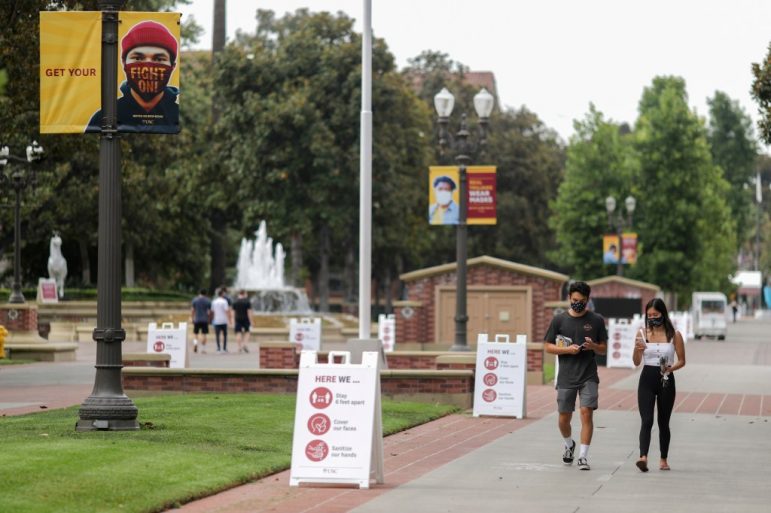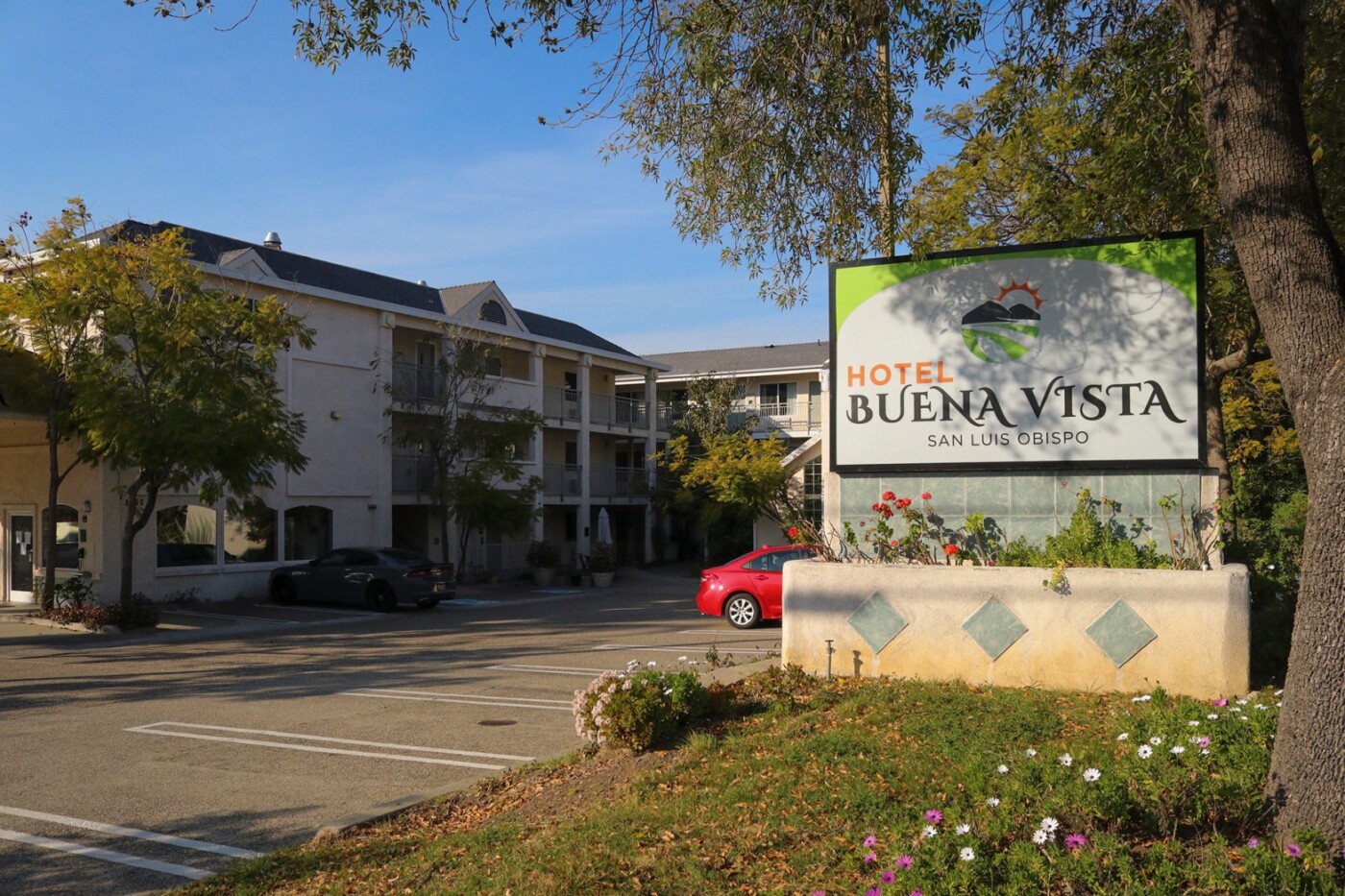California college students are headed back to classrooms just as new COVID-19 cases in the state are starting to decline from the peak of the omicron surge. But that doesn’t mean it’s an easy road ahead for the university administrators tasked with keeping them safe.
How many isolation beds are needed on campus? Should in-person classes be resumed all at once, or phased in?
Those are just some of the questions colleges are grappling with as they head into the spring term, after postponing in-person instruction for the first few weeks of January. On the one hand, many public health experts say the virus will soon become endemic: constantly present, but with predictable transmission rates that health systems can manage without being overburdened. On the other hand, face-to-face learning is returning just weeks after the highly-transmissible omicron variant swept through California campuses, straining campuses’ ability to separate infected students from the uninfected.
“If anything, (the surge) taught us that we can’t be complacent with this,” USC chief health officer Dr. Sarah Van Orman told CalMatters.
Some California colleges are looking to increase isolation capacity and are updating masking policies to require surgical, KN95 or N95 masks indoors. Most say they will continue regularly testing students for the virus, on top of requiring booster shots.
At the same time, universities say they are preparing for a new normal in which we all must coexist with the virus.
“It’s unfortunate, but it means this is going to become something we just need to live with and adapt to in an ongoing fashion, similar to what we had to do in the world around influenza,” said Mary Croughan, an epidemiologist and provost at UC Davis.
Universities aren’t out of the woods yet, University of California Health Executive Vice President Dr. Carrie Byington told the university’s Board of Regents at their January meeting. Byington predicted the virus will become endemic, but she believes the timeframe is in “years, not weeks.”
And while many students are eager for the return to in-person classes, others are wary. Some are pushing back against administrators’ ”live with COVID” mentality. They say universities’ current plans to resume in-person instruction without allowing students to opt out puts vulnerable communities at risk — including disabled students, those who are immunocompromised or those who are caregivers to immunocompromised family members.
Instruction “needs to be in a safe environment, where we are all able to prosper,” Elysha Castillo, vice president of external affairs with UC Riverside’s student government, said during a virtual town hall convened Friday by student activists. “And that means including those who cannot be in person. We need a more safe and hybrid environment.”
Campuses hit hard by omicron
The omicron wave tested colleges’ ability to manage on-campus infections, with sometimes chaotic results.
More than 1,500 students at the University of Southern California needed to isolate after getting COVID-19 in early January, and the university ended up putting students in off-campus hotels.
But in some cases, hotels weren’t enough: UC Riverside officials reported on Jan. 14 that they had no more room to isolate COVID-positive students either on- or off-campus.
Students were also given another option: go home. At Cal Poly San Luis Obispo, students were offered a $400 gift card to its university store if they went home to isolate. More than 200 students living on-campus had tested positive for COVID-19 in just the first week of January, far outstripping the university’s 62 on-campus isolation beds. Some COVID-positive students living in multi-bedroom apartments were told to isolate in their rooms.
It was nighttime when Mia Betker, a Cal Poly freshman who’d tested positive for COVID-19, received an email from the university telling her to leave immediately and isolate in a local hotel — possibly with a roommate she’d never met. None of it felt right, Betker said.
Betker stayed put, and the next day, university staff told her if she didn’t go to the hotel, she had to isolate at home — where three immunocompromised family members lived. Her mother rented a car and drove four hours to pick her up and take her home to Arcadia.
“It’s like the only option that they’re really saying is hotel or home — like, which one do you want?” said Betker.
At Santa Clara University, some COVID-negative students had to share a room with a COVID-positive roommate, said Robin Reynolds, the university’s associate vice president of auxiliary services.
Officials had to move fast, she said, when Omicron struck during winter break — a time when most university staff tasked with pandemic response planning were on vacation.
The university’s isolation beds were quickly overwhelmed, and administrators avoided sending students home to their families to isolate “because then you’re just sending COVID home,” she said. They also decided not to put students in off-campus hotels, as students would have no university supervision and could expose hotel employees to the virus, Reynolds said.
At UCLA, more than 400 COVID-positive students were in isolation by the second week of January. The university never ran out of isolation beds, but encouraged students to isolate at home, spokesperson Bill Kisliuk said.
Freshman Will McLean’s girlfriend tested positive in December, and he figured he’d soon be infected. His mother, Alissa McLean, decided the couple should quarantine at their home in Berkeley, so the three drove seven hours in the rain wearing N95 masks with the windows rolled down to improve air flow.
“They called it the drive of death,” Alissa McLean said. “They were freezing — wind in their face, both with COVID.”

Planning for spring and beyond
Reynolds said Santa Clara University had learned from the surge and established connections with local hotels in case isolation beds fill up again. They have one hotel willing to house COVID-positive students, and another willing to house COVID-negative students, she said.
“I think one of the biggest challenges of the last two years is just not knowing what lies ahead,” Reynolds said. “We don’t know what the next curveball might be.”
UC Merced expects to continue dealing with the omicron surge through spring, said Charles Nies, the university’s assistant vice chancellor of student affairs. In-person instruction is being phased in and larger lectures won’t be held until mid February. Officials also plan to move some students from on-campus housing to apartment buildings off-campus, freeing up more beds for quarantine and isolation. In a message to students Jan. 21, the university pointed to data from Merced County — where cases hadn’t been falling as quickly as in the state overall — as one reason for caution.
But Nies said he hopes the university can shift its response by fall, moving “into more of looking at this from an endemic model instead of the crisis pandemic model.”
As COVID-19 becomes endemic and safety procedures relax, UC Davis’ Croughan said it will be important to maintain a culture where students feel like they can stay home if they’re sick. This includes asking professors to offer recorded lectures to students — synchronously or asynchronously. UC Davis professors can already enroll in an optional program where the university hires students to record their lectures. Professors can post them online for students who can’t attend class in-person, university spokesperson Julia Ann Easley said.
Universities should also provide laptops and broadband to students who can’t afford them so they can access classwork at home, Croughan said.
USC’s Van Orman said she is hopeful that COVID-19 will become endemic by the end of the calendar year. If that’s the case, USC may stop providing isolation housing to students who get COVID-19 starting in fall 2022.
“I think that kind of strict isolation will end relatively soon for COVID-19,” Van Orman said. “We’re already hearing that from some institutions in Massachusetts.”
The American College Health Association released new guidelines Jan. 19 encouraging colleges to distribute or promote N95, KN95 or surgical-grade masks and allow students to get out of isolation after five days only if their rapid test comes back negative. The recommendations also acknowledged that contract tracing might no longer be feasible for colleges given how easily omicron is spreading.
Some students calling for more online options
While administrators are getting ready for a new phase in the pandemic, some students are still voicing discomfort with returning to in-person learning.
Petitions at several UC campuses demanding courses that blend online and in-person learning have garnered thousands of signatures.
Speakers at Friday’s virtual town hall, which included representatives of several UC student governments and the disabled student rights group UC Access Now, called on the university to allow any student to decide whether they needed to continue learning online, without having to provide documentation. Some encouraged students to skip in-person classes this week as a form of protest.
USC junior Lily Bai told CalMatters she was surprised her university went back to in-person classes on Jan. 24 given the record-breaking COVID-19 surge in Los Angeles. Bai said she has several friends who tested positive in the last few weeks and knows others who recently flew into Los Angeles.
“I just wish that we still had an option to Zoom into class if we wanted to, especially for, like, big lectures,” Bai said.
Sarah Theubet, a UC Davis senior who has multiple autoimmune disorders, said she had one in-person class scheduled for winter quarter, but worked with her professor to take the class online.
“I was very vocal with my professor in stating that I refuse to come to campus as a vulnerable person,” said Theubet, who chairs UC Davis’ disability rights advocacy committee, a student-run group.
She said she appreciated that UC Davis was giving professors the ability to hire students to record lectures. Still, professors aren’t required to record their classes, “so it’s not actually a fix,” she wrote in an email to CalMatters.
Instead, she said the university should not return to in-person classes at all.
“It is not safe,” she said.
Zappelli is a fellow and Rashad is a senior fellow with the CalMatters College Journalism Network, a collaboration between CalMatters and student journalists from across California. Federis is the network’s UC team leader. This story and other higher education coverage are supported by the College Futures Foundation.
